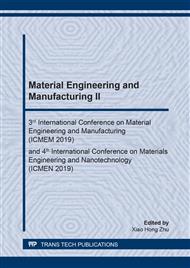p.15
p.25
p.31
p.38
p.42
p.50
p.55
p.62
p.71
Cooling Rate and Microstructural Investigation of Rapidly Solidified Spherical Mono-Sized Copper Particles
Abstract:
Spherical copper particles with diameter ranging from 120.6 to 437.0 μm were prepared by the pulsated orifice ejection method (termed “POEM”). These spherical copper particles exhibit a good spherical shape and a narrow size distribution, suggesting that the liquid copper can completely break the balance between the surface tension and the liquid static pressure in the crucible micropores and accurately control the volume of the droplets. Furthermore, the relationship between cooling rate and microstructures of spherical copper particles was carried out with a specific focus on different cooling atmosphere and particle diameter during the rapid solidification. The cooling rate of spherical copper particles is evaluated by a Newton’s cooling model. It is revealed that the cooling rate was depended on cooling medium and particle diameter. The cooling rate decreases and the grain size increases with the increase of particle diameter during the rapid solidification, while the grain boundary of same particle diameter with larger cooling rate in argon gas is smaller, while the grain boundary of particles with smaller cooling rate in helium gas is larger. When the particle diameter is larger than 100 μm, the cooling rate of the cooper droplet in argon gas achieves 1.0×104 K/s. Meanwhile, the cooling rate decreases rapidly when the particle diameter increased between 70.6 and 149.6 μm. It is an effective route for fabrication of high-quality spherical copper particles.
Info:
Periodical:
Pages:
42-49
Citation:
Online since:
January 2020
Authors:
Price:
Сopyright:
© 2020 Trans Tech Publications Ltd. All Rights Reserved
Share:
Citation:


